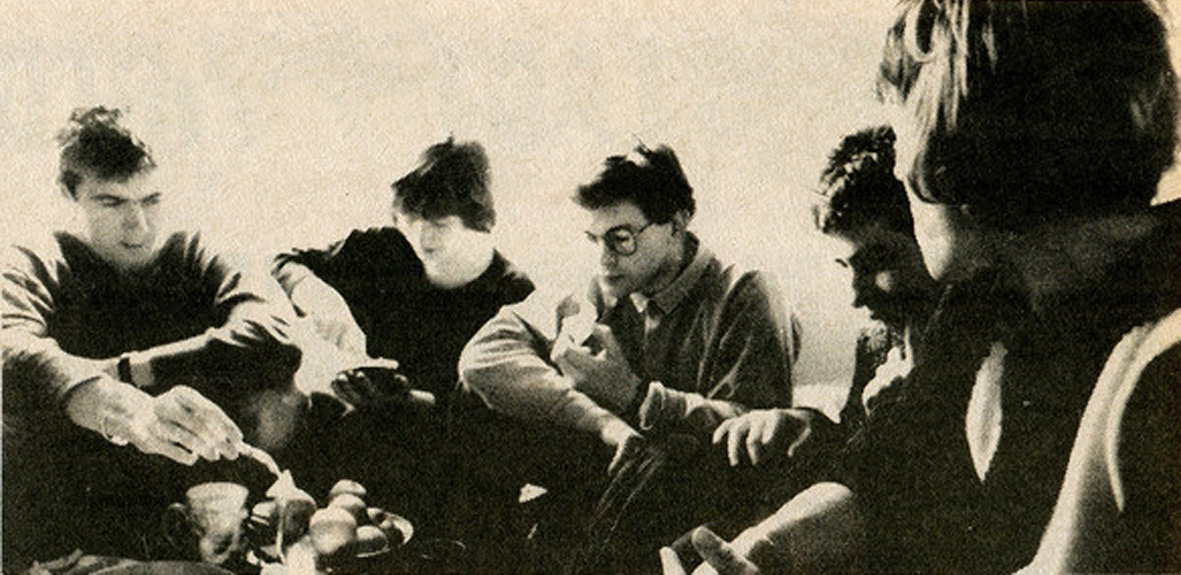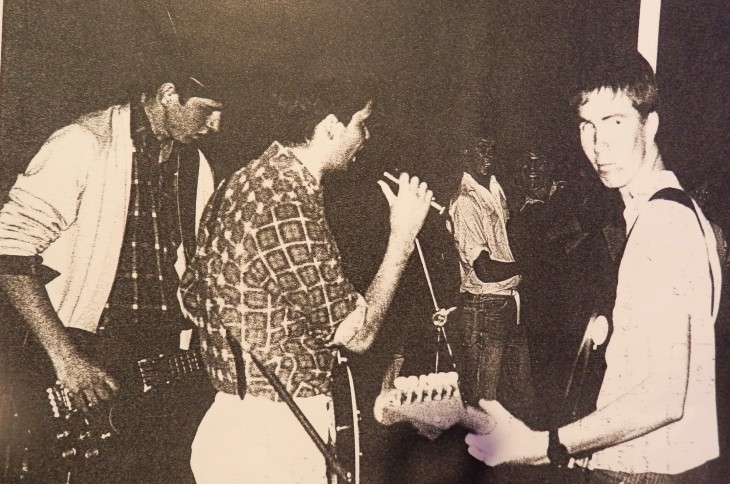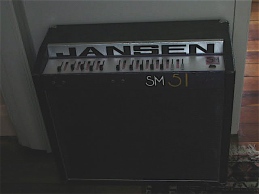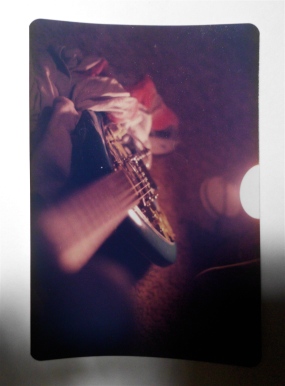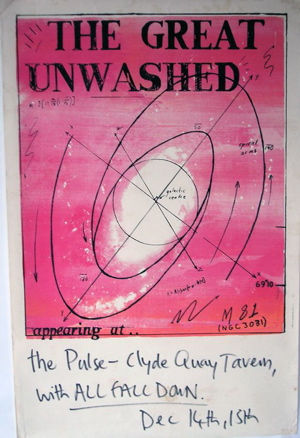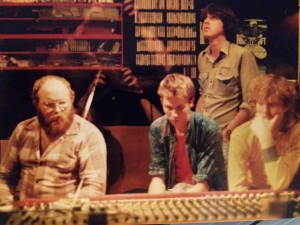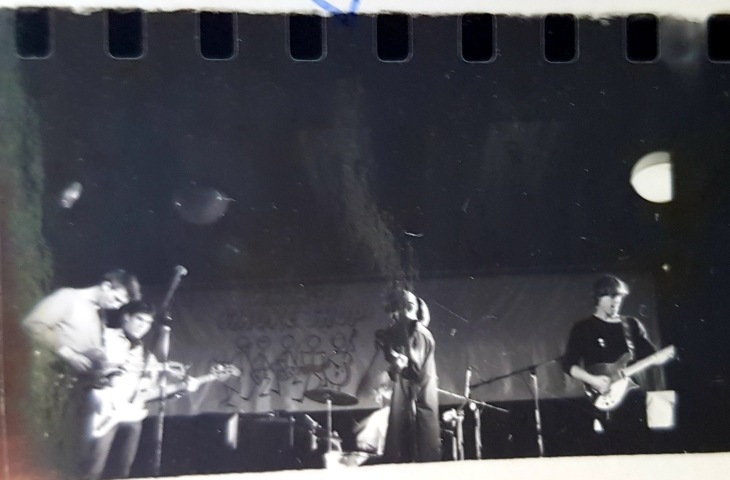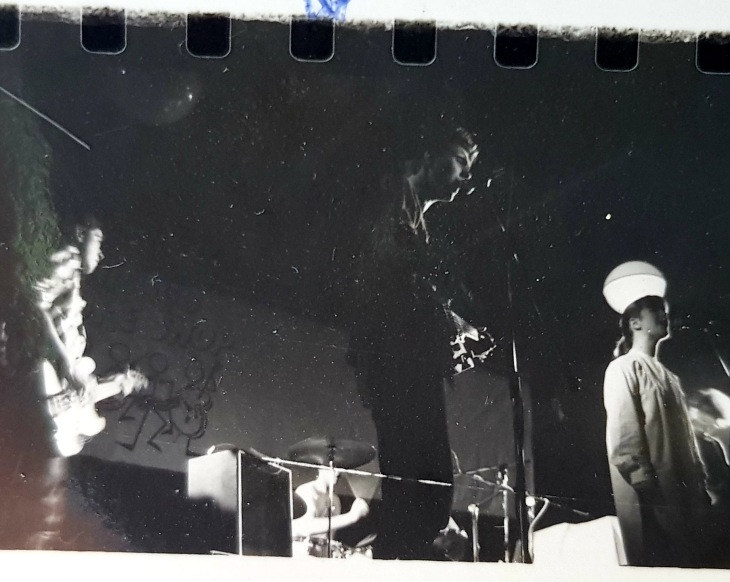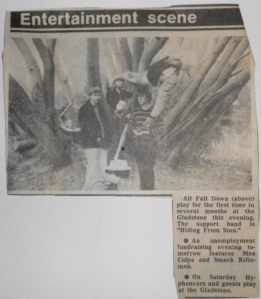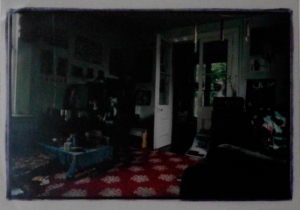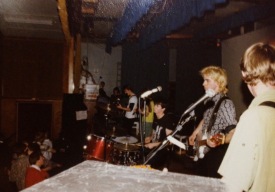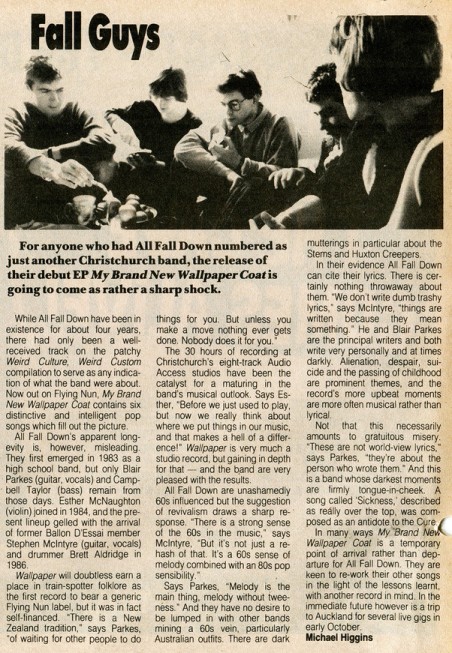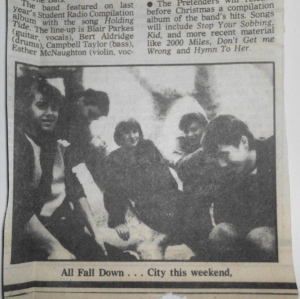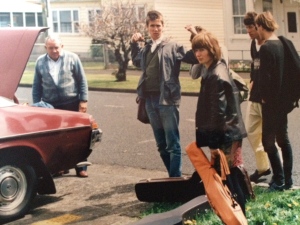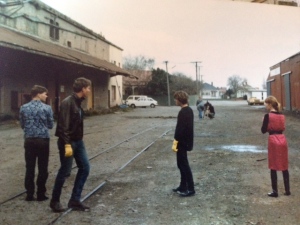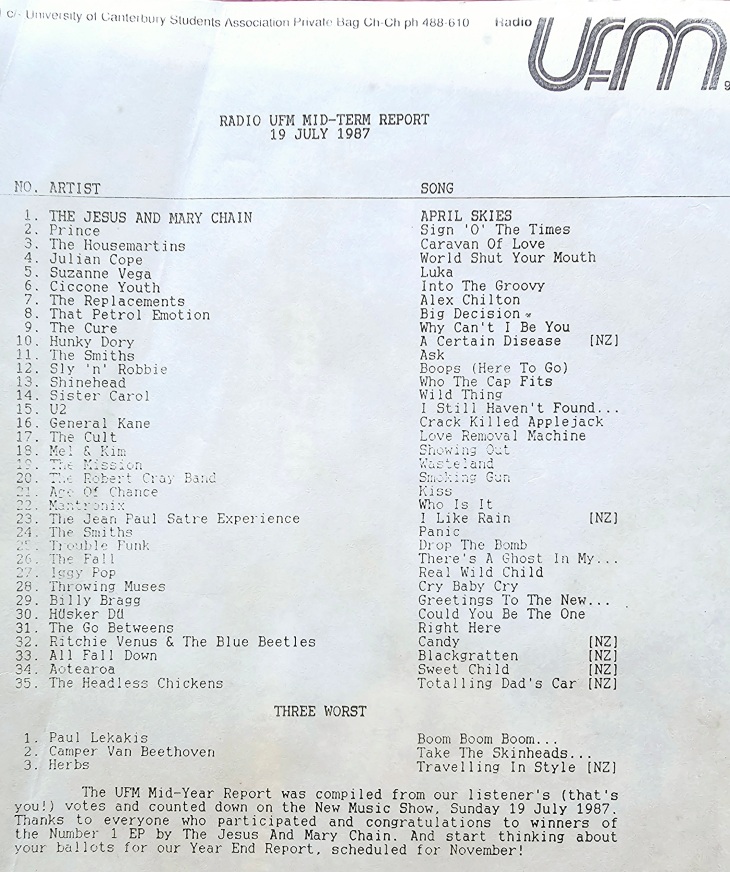I joined my first band in the May school holidays of my sixth form year, in 1983. Initially I played my two keyboards, but within a couple of weeks I began to play my blue guitar. We did some cassette recordings in drummer Chris’s lounge one winter afternoon, and played to a few people in David Robinson’s garage a few weeks later. Then that was it. Chris decided he was leaving. He was a forth former so it was no big deal to us. We’d get someone new.
We experimented with a lead singer. Pete Langham was in our class and really into David Bowie. Pete was an okay singer and fun to be around. He could hold a tune and a Bowie-like pose ! Pete also had the worst acne you had ever seen. Still, it didn’t matter, as in a few weeks there had been some sort of dispute and Pete and I left the band. We talked of starting another band with Pete Fitzgerald from school on bass. Pete’s brother Hugh was in my brother’s class, and was, along with his classmate Stephen Macintyre, one of the two bassists in Ballon D’essai, a band from school. They were two years older than us and about to release their debut ep out on Flying nun. They were a large part of the dozen or so cool kids into original music at our high school that hung out in one damp comer of the School’s western Quadrangle. These kids mostly took art and wore the cooler and more expensive school uniform of dark woollen suits. They added skinny ties and spiky hair to complete their look. The group included past and present member of Ballon d’essai, The Triffids, The Berts, The Deadbeats, The Haemogoblins and hangers on. The band with me and the two Petes never happened.
I first saw Ballon D’essai play in the Lower Common Room at University in October 1983. It was local body election night, and some of us had been counting votes, as a fund-raiser for the Interact club. The Interact club at school existed to ‘do good’ in the community. It was like a junior Rotary Club. I joined as it was one of the few opportunities in a single sex school to meet girls. Interact provided far too few opportunities. That night our vote counting tended towards the creative side of maths. We possibly didn’t take things as seriously as we probably should have. Ballon D’essasi had settled on their later line-up by this time with Matthew Campbell replacing Hugh on bass, and Lyndon Fraser replacing Lindsay Davies on guitar. Their sound had lots of rolling tom rhythms and two basses galloping along with stabs of guitar and yelps, growls and singing over the top. Mark Rastrick leapt about and entertained.
Scorched Earth Policy and The Bats played earlier in the evening. The Bats were instantly hummable and Scorched Earth Policy enthralling. doing a fantastic version of Calcutta Rail. I’d always hated saxophone but here it was great. Later, Daniel, a friend of Damian and Paul, drank a jug of beer, put his head behind a curtain, and vomited all down inside the common room window.
I saw Ballon D’essai play a couple of other times and they were always impressive. One summer they played on the River Bank near the Antigua boat sheds, possibly as part of an Orientation or City Council event. They were loud and energetic. Afterwards Paul Kean packed his bass gear into his triumph Herald and drove off, half the speaker was inside the car, with the other half sticking out the back.
Mathew and Scott from Ballon De’essai later played in The Haemeogoblins, a band centred around the two-year graphic art course at Christchurch Polytech. They were led by another ex-Boy’s High pupil, Lawrence van der Lingen. They played a sort of risqué funk a bit like Ballon d’essai. I saw them once in the Upper Common room. They’d decorated the room in paper mache, day glow stars, hearts, cupids and phalluses. Their performance was fun and theatrical. They usually had backing singers and sometimes Larry Owens and others would go go dance. Like Mark, Lawrence was a front man not hung up on singing the safe notes. The Haemogoblins line-up evolved over the years. My old friend Penny joined on backing vocals towards their final push to promote their album that was eventually released on Bill Direen’s South Indies label.
Our band continued writing songs and looking for a drummer. Stephen Todd, a friend of my brother’s since I was nine, played with us for a while, but it wasn’t really his thing. We had a drummer wanted notice at CJ’s. It said: “people say we sound a bit like the velvets but we’ve not heard the velvets’. Brett Lupton responded. He was a year older than us and itching to be free of his time as a lance corporal in the army. Brett drove a blue Hillman Avenger he’d bought from his used car salesman uncle, and played a lot of toms. He came from Otorahonga, really liked Talking Heads, was fun to be around, and added heaps of enthusiasm to the band.
We practiced a lot after Brett joined. Our first gig as ‘Va va Volunteers’ was in Damian’s parents’ carport in Holly Road. The party was to celebrate our sixth from accrediting results. My friends and I had all been ‘accredited’ sixth form certificate and U.E., based on our year’s internal assessment results. It meant no exams !
I was excited and nervous before the gig, and a bit grumpy. Things had got nasty at home. Campbell was ‘banned ‘ from my parent’s house for years. We’d experienced a similar bad vibe during our sound check / practice under the carport at Damian’s that afternoon. A guy our parent’s age had marched in and had a go at us for the racket we were making. He was probably a teacher. He was angry. “I appreciate the need for you to practice, it’s obvious that you need to, but I’ve got four students over there who are trying to study for their U.E exams”. The party gig went fine for us, gone in a blur and really loud. David Hopman wrestled a guy who went nuts with numb chucks. David played it down to his dad as he drove us home in one of their two Viva station wagons.
Damian had followed in his father Henry’s footsteps by making things. While he was at University in Dunedin, Henry had built himself a car. Apparently it looked like a tank. During Damian’s childhood Henry built the family a metal accommodation unit on the back of a small truck. Later, during Damian’s high school years Henry built a ten-meter long, concrete hulled yacht, ‘The Bird of Passage’. Damian had grown into this environment of making things and had been tinkering with electronic projects since boyhood. He had a soldering stand and an oscilloscope, and in his early teens made a fuzz box and a modulator. Later, Damian’s emerging interest in music led to more guitar effects, amplifiers, speaker boxes, a spring reverb, and mixing desks. Damian took it as far as designing and making printed-circuit boards for a multi-channelled, multi-bussed, multi-eq-ed mixing desk during his university years. He hand-etched the circuit boards using a batik / resist technique with oil paints.
The band continued to practice over the summer months. We called ourselves ‘The Volunteers’ and later ‘All Fall Down’. I was playing a mixture of blue teardrop guitar and clavichord / electric piano through a Jansen Sm 49er amp. Soon after purchasing my Diplomat bass, my father had set me up to buy an amp from friends of a friend, Ishwar Ghanda, Hornby’s most well known Indian DJ. Ishwar recommended ‘Musical Specialists,’ a guitar and amp shop in Colombo Street near the town hall. The shop seemed to be a partnership between Phil Garland, the folkologist, and Bob Mould, a guitar maker. Bob Mould’s instruments seemed to be mostly strat shaped and he had a good reputation. My Dad said to me ‘you can’t drive to school on an amp’, but still set up the deal. I bought it straight away.
The Jansen Sm49 was a big, heavy and useless 70’s thing. All mouth and no trousers. It had large rheostat sliders for volume, bass, mid, treble and precence. In reality, these did little. It had little more than basic tone and volume controls. The cabinet was enormous. It stood waist high and was a meter across, and a foot deep. The metal was brushed silver and purple metallic paint with white and yellow detailing, with JANSEN writitten in big black letters at the back. It had one twelve-inch speaker lost behind a faded ribbed cotton front cloth. The exterior casing was fake alligator skin vinyl. Although it was big, heavy and ineffective, at least I now owned an amp. It could handle bass, guitar and keyboards, but was too gutless for vocals. It had two input sockets and big carry handles on the sides. I was glad to trade it in one study period at Andrew Balfour’s in Colombo street. My new amp was an Eminar 65 watt combo. They were a good, small, rugged, overly mid-ish sounding amp that was easily carried around. It had an overdrive knob and a reverb. Mine also had a stain down the front fabric I couldn’t get rid of.
Campbell started with an Alron bass amp -50 or 60 watts. It had similar qualities to the jansen. Alron’s were the amps people started with if they hadn’t bought a jansen. He traded it in on a bass cube. Roland cube amps were a revelation. Small, light and bright sounding.
I was mainly going for a jangly guitar sound. The eminar’s reverb and selectable mid cut and boost was a great step forward in that regard. I had also moved on to using semi-acoustic guitars. The first one was a President 335 type shape. Cj’s put in an Ibanez pick up giving it a more direct sound., further emphasised by sticking one of Stephen Carr’s “caution: nerve gas” stickers on it. I decorated my guitars a little in those days. I had used electrical tape to make the diplomat bass a bit more punk rock like I’d seen ‘No Tag’ do. Later I painted large yellow flowers on my bright orange Maton firebird. They really worked.
Not long after the party at Damian’s, we played at an afternoon party at Marcus Puentener’s place. Marcus played drums for ‘scab union’. We joined ‘the scabs’ and ‘The Axemen’ playing on the terrace to a friendly audience sitting on the lawn in the sun. Stuart Page, the Axemen’s drummer said,“Play more keyboard songs’. We played less.
I always think of ‘gigs’, not ‘shows’, ‘concerts’ or ‘performances’. It shows my age. Most people who play music these days talk about playing ‘shows’. ‘Show’ suggests at least a small degree of showmanship, and that’s not been something I’ve often felt natural doing. I was ok slipping into what most good bands seemed to do at the time, which was virtually nothing. No jumping around, just playing, standing still, trying to get the songs and the words right.
In January 1984, we hitched aboard a gig with The Axemen at the Star and Garter. It was our first pub gig and our first with a big PA. Ben Stockwell and Greig Bainbridge ended up mixing us that night. Ben was in The Triffids, the third band of the evening. We knew Greig from school. He wore a dark suit . He was two years ahead of us, and had allegedly uttered the highest-ever altitude ‘woot’ enroute to New Caledonia on a school French trip. Our old neighbour Jonathan Keeble was in the Star and Garter’s garden bar during soundcheck in the afternoon. Lots of our friends from school came to see us play. It went past in a nervous blur and it seemed ok I have a cassette from the desk recording of the gig, and it proved to be an early lesson in the drawbacks of desk recordings of live gigs. They usually suck, with loud flatly sung vocals, big reverb-ed snares, kick drum and little else. Because we were underage, we made sure to leave straight after we played. We loaded the gear into our cars and just as we were about to leave the pub carpark, a Zephyr drove up to us out of the dark and asked if we wanted any smack.
this advertisement featuring a Stuart Page graphic was in the paper the day after we played.
We ended up playing lots. We were usually paid $50, which was about half a weeks pay week in my first year of work. We supported people like The Bats, Scorched Earth Policy, and The Netherworld Dancing Toys during my seventh form year. Other bands treated us well. They put up with our earnest naivety, encouraged us and paid us. Most of the gigs were at The Star and Garter and The Gladstone. In those days bands often played three nights in a row. A venue could be packed by a good band playing Thursday, Friday and Saturday nights. We mostly played to empty rooms early in the night, to allow for 11 pm closing. Both pubs had big noisy PAs in their lounge bars. It was the time of enormous W bins and regular shocks from the mic. We learnt to take a clean sock to our gigs to put over the mic. in case the PA was badly earthed.
[image courtesy of Matt Goody]
There were regular Saturday afternoon gigs organised by the A.E.B. – the, “ Alternative Entertainment Bureau”. They were a local ‘anarchist’ organization who ran gigs about town. There were two Johnnie’s involved – John Bridges and Johne Leache. John Bridges was tall and did a lot of sound. John E. Leach was small and grey, and seemed to be more involved in the organisational side of things. There were also a large number of gigs in places other than pubs. There were a lot of events at places like the State Trinity Centre. Multi-band line-ups with great posters. Steve and Stu from The Axemen called themselves ‘ink/inc’ and made some of the best. We played in freezing deafening halls all over Christchurch, often on a Saturday or Sunday afternoon. Most of these gigs featured The Axemen and Scorched Earth Policy. Everyone shared gear, usually there was no P.A. and vocals were seldom heard. You’d always go home cold, deaf and a bit exhausted.
We’d been looking for a singer ever since Pete Langham days. We’d advertised on the notice board at CJ’s and had tried a couple of people. We met John Greenfield through the noticeboard when he was roadying for Rockococo. John came around and sang a song of his; “Your big brother, has started a war’. We responded to an ad Esther McNaughton and Rita Le Quesne had posted at CJ’s. They were a ‘punky-singing duo’ looking for a band. Esther turned up for the first audition and Rita didn’t. Esther sang with us a little at practice one night, she seemed fun, so we asked if she’d join us on violin. At that time Scorched Earth Policy, and before them, ‘The World’, had a great player called Andrea on violin in their line-up, so we knew it was a good idea. Esther was from Sumner and was in her seventh form year. It was two bus rides for Esther to get to practice, but she was keen. She had a mo-ped too, but Sumner was a long way to ride at night after practice. I started dropping her home and we started to hang out together. One night she cut my hair and afterwards we watched Alien on TV, making the most of the scary bits.
We travelled to Wellington to play at the Clyde Quay Tavern right on the waterfront with the Great Unwashed early the next year. I was working at The Press and Esther was at Teacher’s college so we flew up while the others took the train. David Kilgour wasn’t in the band at that point and the line-up for this trip was Peter Gutteridge, Hamish Kilgour and Ross Humphries, accompanied by George Henderson on a few songs.
The gigs were good. I remember looking off the stage as we played. One side of the room was a long picture window looking directly out over the harbour, and on the Friday night it was filled with fireworks and their reflections.
George blew my speaker and I impersonated Jordan Luck at one point. The Great Unwashed were generous and gave us $300, half their guarantee. They played Humphries’ “No’, the Gutteridge songs and George Henderson’s ‘Christmas in the country’. “No’ and “Christmas in the country” are two of my favourite songs.
We had other trips away from Christchurch. We took a bus ride down to Dunedin to play at the Empire with Robert Scott and his brothers’ occasional band, ‘Electric Blood’. Campbell and I stayed the first night at Robert Scott’s flat in Carlyle Street. We froze all night where the rear-dripping wall seemed to be part of the hill the house sat on. Another time we drove down to Timaru in my mum’s Toyota station wagon. She had instructed me to keep 10 kms under the speed limit. I did what she asked and it was annoying, especially to Brian Young, our Drummer. Brian was a few years older than us and was finishing his honours year of a Bsc in Psych prior to applying for scholarships to study in America. He’d previously played in a successful pub rock band, ‘The Sheer Fanatics’, with Brent Cain, who I ‘d worked with at The Press. We played at Timaru’s only nightclub, “The Old Mill’. We played with ‘Vague Secrets’ and stayed in an old cottage in Pleasant Point on John Christoffells’ parents’ property. The Old Mill was the only place in town where you could get a drink after 11pm closing time, so it attracted a wide range of the city’s drinkers. It was probably the wrong place for me to experiment with mascara. I did some backing vocals and tambourine for Vague Secrets and kicked out Paul Girls’ guitar lead. Earlier, during our own set, a fat gut in cowboy boots got on stage, calling me a faggot as he tried to grab my guitar.
We began practicing after hours in Campbell’s mum’s clothing alterations shop in Riccarton Road. Our friend Creon had a couple of practices with us on drums, but in the end Brett bought her drums, and was back behind the kit.
I played at my first of ten orientations in a row in 1985. Orientations were a big deal in the early 1980s with big budgets and big line-ups. Orientation controllers had a lot of power and money at their disposal. Occasionally you would hear stories of excessive behaviour and consumption by festival organisers and their helpers. From the mid eighties Orientations gradually decreased in size as Universities themselves changed. Student fees increased and university culture changed. Universities followed international trends, gradually moved away from the fostering the arts towards more industry driven commerce and science faculties. There was a gradual reduction in politics, alternative culture and black clothing around campus as the eighties moved into the nineties.
1985 was my second year of working at The Press. I’d got the job through the careers lady at school the year before. I’d stopped doing schoolwork outside school early in the sixth form. By the seventh form I had long lost any interest in school. I was looking for a way out. Outside of school I was really busy. I cleaned the offices of Wang Computers every morning before school as well as working three nights a week at Symon and Lowther. I had the band as well. I had continued the ‘no-homework’ approach into the seventh form, but it clearly wasn’t going to get me through a second year. All the subjects I had taken seemed harder. It was arranged for me to spend a day with an advertising agency in Riccarton. I spent most of the day in the art department. One guy there mentioned that his brother Simon was a lead singer in a band more often than was necessary. At lunchtime he went home and came back in leather trousers. The next week I spent a day with the advertising department at the Christchurch Press. At the end of the day, I was offered a job in ‘ad-services’, walking around town delivering advertising proofs. It was only two days a week, Thursday and Friday. Excellent!. I left school the next morning, handing all my books in before morning interval.
After a couple of months my job at The Press became fulltime and I began riding one of the company motorbikes. My only previous motorbike experience was an afternoon spent riding an 80 cc Yamaha kids bike at a YMCA day camp in Masterton when I was twelve. Quentin, my co-worker at The Press spent half an hour teaching me the basics of gear changes in the Press basement. After that we were off, out into central Christchurch and heading for the back streets near the airport. In the basement there had been concrete pillars and classified ad. Salesmen to avoid. The open road had cars, vans and enormous trucks to stay clear of. Out of necessity my riding quickly improved and I was soon enjoying riding all over Christchurch in all kinds of weather. We went as far as Southshore, Hornby, Redwood and the Hoon Hay valley. There were deadline driven pressures, parking hassles and heavy postbags to balance on the petrol tank. Wet days were no fun, but the fine days were fantastic. You could go out for hours. There were two of us on bikes, and an older kid who’d done our job before us, helping our boss Phil with the paper work in the office. Phil was a good guy doing his best in a workplace that didn’t show a lot of respect for him. He was a short man with a big waist and a bigger wife. Phil’s mum still made him a lot of his clothes, including several pairs of high-waisted royal blue nylon slacks. Phil had a poster up in our area that said ‘its hard to fly with the eagles when you work with turkeys’. Phil had a number of sayings. His immediate response whenever I asked for time off on a Friday for band things was ‘not on a Friday mate.” It was a drag.
At work we rode Hondas. I started on a yellow CG 110, and after about six months The Press bought two new, black Honda CG 125’s and two new sets of wet weather gear from Casbolts across the road. It didn’t mean we’d ever be dry in the rain, but at least we got less wet. I was a pretty cautious rider. I had a few slips on white road markings but no real accidents. Murray Crane, my opposite at the Star, broke his leg two or three times on Star Suzukis. Buses and taxis and road markings were best avoided. Once riding outside Noahs Hotel, I sneezed off a temporary cap from my front tooth. It dropped onto the petrol tank as I tried to perform a one handed emergency stop in busy traffic . As I grasped for the tooth balanced on the petrol tank in front of me, the freezing air rushed straight into my tooth’s exposed nerve. Another time I was riding past the Barrington Mall entrance when a bee flew into my helmet through the open visor. It got stuck between my jaw and the helmet. I attempted a tricky one-handed pull over and stop. I was stung on the chin.
The band’s social life was now increasingly based around 87 Cashel Street; a warren of rooms above and behind shops owned by Anthony Gough. The area housed band practice rooms, some living spaces and The Blue Ladder Theatre / Gallery. Esther and I had gone up to the gallery early in its life to see an exhibition. Inside it was freezing. We introduced ourselves to Bill and Carol, who were huddled around a two bar heater with their young baby. I offered to help about the place. I was still only working part time at The Press and my parents wanted me to spend my days constructively. I had taken up an ‘art for fun’ class one morning a week at Hagley and I began to dabble in set painting and props construction for Bill and Carol. It was great fun. I painted, made a rifle, a linocut business card and worked on a street scene for ‘The bride of the wheel’. I did some shadow work and percussion in ‘The Epic of Gilgamesh, a scheme that Bill, Carol and an artist they didn’t get on with, were on.
We ended up hanging out with Bill and Carol at the gallery and their flat in Montreal Street for a couple of years before they left for Wellington. Bill gave me his old Hotcake. Damian fixed it up and added a second, thin-er overdrive sound. There was a lot to do with Bill. Gigs, films and plays. A lot of organised and impromptu performances and parties happened at the gallery. We did an afternoon’s recording on Bill’s four track. It was a freezing day in the middle of winter. Strings broke and we got scratchy. We all got headaches.
The recordings were no good again. We’d had a tentative agreement to do something with Flying Nun and had hoped this session might have helped us get there. We had done a few recording sessions in a few different places and none of them had ever been very good. We’d had a few sessions at Damian’s parent’s house, using his home made mixing desks and EQ’s. We’d also demo-ed six songs at the first Nightshift Studios in Wilsons Road when Stephen Todd was in the band. Unfortunately none of our recordings ever sounded that great the next day when we listened to them. We either sounded too weedy and thin, or we’d played or sung badly. The quality of my songs usually didn’t help either.
recording in Damian’s parent’s lounge, 37a Holly Road. [1984]
l-r ; damian, blair, campbell, esther, brett . Photo courtesy of campbell.
At nightshift studios, Wilson’s Road, Christchurch. 1985.
l-r : arnie van bussell, blair, campbell, stephen. Photo courtesy of campbell.
We’d all been steadily upgrading our gear. Campbell, Esther and I all had reasonable amounts of work to afford our gear-buying hobby. We visited the music shops at least weekly and eagerly read the musical instruments for sale classified in Saturday’s Press . I had sold my synth and electric piano /clavichord to a music shop in Riccarton early in 1984. I replaced those with a Yamaha YC 10, bought from Peter Dowling, a friend of my brother, for $350. It was small, heavy, red organ with legs that screwed into the corners underneath, looking a bit like a table. The bottom octave had reverse black on white keys. A couple of years later I sold it to Mary Rose Wilkinson who started playing it in The Max Block.
I changed guitars the way my dad changed cars. I bought and sold two Maton semi-acoustics, a Maton firebird, a Yamaha jazz styled semi-acoustic, a Rickenbacker solid body with sloping frets, and finally a Gretch Firebird. When I asked to try the Gretch in the shop, the sales assistant, was a real creep. He told me it was an expensive guitar and I was not to scratch it. It looked and sounded great and had a master volume knob. Excellent. I paid cash. Each guitar I bought was a step ahead from the last in quality, sound or playability. I had told my parents the Rickenbacker was the Rolls Royce of guitars. When I sold it they asked me why I was selling my Rolls Royce of guitars? Esther gave me a Hofner semi-acoustic for my twentieth birthday. We got it for $85 at the auction rooms on Manchester Street. It had a set of detachable Commodore pickups screwed on – the same as Uncle Ian had used on the guitar he made. I sold Esther the Eminar amp and bought a Holden graphic 200-watt head and a 15-inch midrange speaker and bin. For a while All Fall Down had a backline of three Holden graphics. It looked a lot better than it sounded. I sold the graphic and bin to Hugh and bought a Fender Twin from a guy in Fendalton for $1000. Valves. Fantastic.
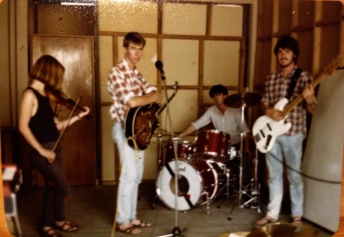 photo: Damian Zelas, courtesy of Campbell
photo: Damian Zelas, courtesy of Campbell
Brett was soon living in one of the spaces at Cashel Street and we began practicing there. We soon met Brett’s neighbour, John Christoffels. John had been living in his band’s practice room for a few years. It was cheap and close to everything. Not many people lived in town in the mid eighties. Warehouse living was reasonably new to Christchurch and possibly not supported by the council. John was quite well set up in his space. He had a fridge, a microwave and a practice area. He shared a shower and toilets down the corridor with the other tenants. John was twenty-five, five or six years older than us. He had recently quit his long-term job as wages clerk for the Ministry of Transport, sold his TV and had started a BA at Canterbury. Twenty-five seemed old to be starting a degree.
photo: courtesy of Campbell
We began spending a lot of our time up at Brett and John’s. John was welcoming and generous with his space and time. Hanging out, watching films, playing music and broadening our horizons, initially with alcohol. All fall Down played a set at Brett’s 21st at John’s place. Wine cooler was brand new and yet to earn its suburban associations. I drank a lot of orange ‘kool’ wine cooler that night. A delicious orange fizz. Later in the evening Jonathan, John, David Jamieson and I played Brett a biographical song I’d written for the occasion. Brett was given comedy underwear from his workmates at PDL. David’s band, ‘A Fragile Line’ had been practicing in a room near John’s and we’d got to know each other. At another party Campbell wore the leopard skin tights we given him. Another night we played a game where a balloon is blown up and passed onto the next person. The suspense builds until the balloon pops. I got the fright of my life when it did.
Brett left his job at PDL and ended up living around the corner from John in an adjacent warehouse behind Hamco Spares. The large part of the space hosted several Flying Nun Christmas parties and a bath. Brett’s flatmates Guy Tredgold, Graeme Jefferies, David Read and Ken all put up with our noisy practices over a few years. We had a novelty covers band for a while called ‘The Hot’. John, David, Brett, Jonathan and I were the members. ‘Superstition’ by Stevie Wonder was one of the songs we butchered. We all shifted around on instruments with two basses in most songs. It didn’t last long.
After practice above Hamco Speed, Oxford Tce, 1986 , courtesy of Campbell
l-r : Campbell, Jonathan Hall, Stephen, Blair, Brett.
The day before I moved in with Esther and Andrew was the first day of Teachers College. In the morning I sold my car for $4000 to a dealer from Blenheim. It was a good order Honda civic that I had payed $4400 for it eighteen months earlier. Cars were a lot more expensive before Japanese imports came in and prices dropped in half. The Civic was a small hatchback. It was good for getting around town and you could fit a bit of stuff in the back with the seat down. It wasn’t that great on hills, and I decided it was too big an asset for a student with little money. My Dad was still right. I couldn’t drive around in an amp.
On my second day at Teachers College my parents arrived back from holiday. One of them asked if Esther had found a new flatmate and I said, ‘yeah, me.’ My father said that if I moved in with Esther, I was not to come back.
lounge, f3 17 kilmore street, approx. 1989. Photo Mark Heslip
My weekly share of the rent at flat 3, 17 Kilmore Street was $21, my food bill $18. I got $42 a week allowance from Teacher’s College so I was okay. I had saved enough money working the year before to give me $20 of savings to spend every week. I only needed to make it on this budget for one year until I was 20 and entitled to a living away from home allowance. Not too far into the year I got a lawn-mowing job over near Teacher’s College earning another $20 a week. I felt loaded.
Esther had been a vegetarian for ages and over a couple of years I also stopped eating meat for good. For a long time the only meat I’d been eating was an occasional sausage roll, and that didn’t seem a good enough reason not to give it up. Nothing needed to die for me to live.
Our flat was part of a large old wooden building containing nine flats. The building was in two mirrored halves, each containing four flats. There were all sorts of people in and out of the flats. I heard our place housed prostitutes in the 1950’s. It definitely seemed like it had been purpose built as a number of flats, and then possibly divided further. Our flat was upstairs at the back on the left as you faced the house. Esther and I shared two rooms – a sunroom off the lounge and another bedroom. Our flatmate Andrew bent his 6’4 frame into a single bedroom not much bigger than his single bed. We had a kitchen big enough for a small table, stove, fridge, bench and a small drum kit. The bathroom was gracious and big; a toilet with a view, a claw-foot bath, black and white lino checks. Our flat was mostly only one room wide and it could get really cold. Sometimes when the wind blew it felt like a small ship, the branches from the surrounding oak trees lashing it in the wind. I lived there for the four years. Two with Esther and two more. It really swayed in earthquakes.
Our family had spent a number of years circulating audio cassettes of family news to each other around New Zealand, and overseas to Aunty Beth and Uncle Henning in Germany. It was mostly on Orange BASF’s which would get increasingly worn out as each family added their news over the top of someone else’s old stuff. I remember my parents complaining about the decreasing quality of the tapes but not buying new tapes, as they were still expensive. Our segment occasionally featured bad recordings of my brother and I playing ‘our pieces’ on piano. A mess of roomy clonks with overtones as the condenser mic. overloaded on the worn-out tape.
I begun taping all sorts of things once I got my first cassette recorder. I got a recording of our old cat Mog’s hisses.I taped songs off the radio. 3zm were playing new music from the UK. New Wave, ska and local music had reached commercial radio. We heard The specials, Blondie, The Cars , Misex and The Pretenders and The Crocodiles. Radio U was only on for a few weeks each year but we listened avidly.
Once I started writing music I began taping that too. My awful first few songs on the piano repeated the mistakes of the family piano recordings. I did lots of stuff with David, Campbell and the band too. If we jammed we taped. I also did a few tapes with Michael Morgan as ‘Yay Combustabrics.” Tapes and cassette recording had become a popular way of releasing independent music. The EMI shop in Colombo Street sold tapes by The Axemen, Pete and his Pigeon’s, The token blacks, Steve and his Stingrays -all of Steven Carr’s stuff.
Like a lot of people, I began bouncing between two radio cassette decks in 1983. I would record onto one cassette tape, then play that back while playing something new over the top of it, recording it all onto a second tape recorder. You could keep adding stuff but the quality dropped quickly. We had seen The Police using an early Tascam Portastudio on Radio With Pictures to record demos at Monserrat, building up songs in front of us. It seemed fantastic. For something so small you could do so much with it. Portastudio’s became more widely available in 1986 the year I moved into Kilmore Street. Fostex X15 II’s were also on the market a few hundred dollars cheaper than the Tascams at $799. That was roughly six weeks pay, if I’d still been at The Press. I found that with my savings and the money I was making lawn mowing, I had enough to buy a Fostex. I bought it through the Rockshop using my mum’s credit card. It came by courier. I got it out of the box and started recording as much as I could. I remember thinking ‘I’ll never be bored again”.
For a lot of my time at Kilmore Street I had two rooms. At $60 a week it was a cheap, convenient and comfortable flat, and I was only paying half of that. The sunroom had my bed and a TV in it, and I used the small single room for recording. It was really cramped so guitar heads and mics frequently hit the walls, but I could leave things set up. I worked out a plastic bucket drum technique there. You could add some loose paper on one bucket to function as the snare. The other bucket worked as a room tom / bass drum. Everyone else in the house probably heard everything I tracked in that room. I could certainly hear everyone else’s noise through the thin connecting walls. I could have thought a bit more about that at the time.
All Fall Down kept up our eager momentum. We played as often as we could and started to support bigger bands. We seldom played headline gigs. It always seemed a step further on than we seemed to be. Campbell, Esther and I were joined by Stephen Macintyre and Bert Aldridge in 1986. Stephen had Ballon D’essai’s Holden graphic and a Rickenbacker twelve string. When I was a third former he’d sold me a Split Enz badge he made. I chose the size of the badge and which album’s graphics to use. I chose Dizrythmia.
Stephen’s playing was always considered and added qualities to the songs well beyond what I felt able to do. Stephen pushed us up a step as musicians. He only added three or four songs to our repertoire, but they were all especially good
live at Shirley Boys High / Merrin College Dance, Shirley Boys High School , 1986 ?
Stephen, Esther, Brett, Campbell, Blair. Photo by Damian Zelas, Courtesy of Campbell
All Fall Down somehow became one of the two Christchurch bands chosen to appear on a National Student Radio compilation album called “Weird Culture Weird Custom” sometime around 1986 or 87. It was still a few years before Bnet . It was arranged for us to record one of my songs ‘Holding tide,’ for free at Tandem studios, upstairs in Colombo Street. The song was about a swim I had taken in the Dunedin Harbour one autumn. It was the first and only time I’ve raised the key up as the song went on. It worked. I’d been up to Tandem Studios about five years earlier, as a member of ‘The Newz’ fanclub. The band was briefly back from Melbourne and were recording ’ Punk nursery rhymes ‘ as ‘The Rotten Eggs’ for Music World. They were making the songs up as they went along. I’d not known you could do that. Eric Johns engineered both the Rotten eggs sessions and ours. Eric was a very cool African American guy married to a New Zealander. He had been in‘Heatwave’ who had struck it big with ‘Boogie Nights’ and another couple of disco-era hits. Eric was easy to work with and really good at his job. His approach was to track things in such a way that you didn’t need to move any faders during the mix. All the dynamics and power were captured on the initial take.
 [The Press 30-07-87, courtesy of Matt Goody]
[The Press 30-07-87, courtesy of Matt Goody]
Band photo Angus McNaughton [ courtesy Rob Mayes / Campbell]
Early in 1987 we started some new recordings at Audio Access, a newish eight-track studio in Bedford Row. We did Stephen’s three songs and three of mine. The studio was partially managed by Chris, the former bass player of ‘The Solatudes’. The Solatudes included future Wastrels singer Anton Jenner, and had a small local hit with a single, ‘Mother suburbia’. Chris and his English girlfriend were bookings The Old Star Tavern on Lincoln road as ‘Burning House Promotions’. They had an office next to the studio.
Audio Access was a good basic eight-track studio. Tandem had been sixteen track, but eight tracks was cheaper and probably enough. Ben Stockwell was the engineer. Ben was a year younger than us, very talented, and already living a hard life. The recording went ok and Ben did a good job. There were two sessions to do the backing tracks, a couple for vocals and overdubs, and a couple more for mixing. My amp crapped out so I borrowed Mike Bell’s small Fender Princeton valve combo, that Kaye Woodward had bought back from the UK. Stephen’s songs were recorded at a higher tape speed and sound better for it. We’d decided that Stephen would take a leading role in the direction of the recording, and we got it. Stephen mixed it, and okayed the cover. The record sounds a bit eighties, but it could have been a lot worse. Ben did a great job. We were a little naïve about how we should or could sound in a studio. Most of us felt we didn’t know enough about how things should sound to comment or suggest changes. Like many other recordings by lots of different bands, this recording was primarily coloured by the engineer’s sensibility. Like Stephen, Ben filled the gaps in our own experience with his own. It’s what happens when bands don’t know what they want. It happens all the time.
The songs came out a couple of months later as ‘My brand new wallpaper coat’ ep on Flying Nun. Graeme Acton made a video for ‘Black Grattan’ and we played in Auckland with ‘the Letter 5’. Bert somehow scored us a slab of beer from Bevan Sweeney who was booking the venue on the Friday night. I lost my voice the next afternoon before the final gig of the trip. Stephen and Esther covered it. We drove out to Piha and I met Andy Moore.
Unloading the gear at Richard James’ house, Sandringham, Auckland. July [?] 1987
recording the video for ‘black grattan’, addington 1987
l-r : bert, blair, stephen, film crew, esther
I had taken some time off Teacher’s College to do the trip and returned to a pretty bad vibe in the Art department, where I was majoring. Other students had been awol and our teacher was pretty uncool about it. It was another of those times I was expected to choose between the band and a‘real job’. The ‘real’ job people always think you should choose them.
UFM Midterm Report, July 1987, courtesy of Campbell
We had a few other gigs in different sorts of places; in shops, outside shops, parties, the Arts Centre Market, and then finally a release party at The Old Star Tavern in Lincoln Road. The band’s music had gotten better over our final year but our friendships had ground away. Lives were changing, and sometimes things were a little tense.
We played one last wild gig at a party in Oxford Terrace and that was it. Stephen headed overseas with Romily, Esther and I split up.
Stephen And Ben both died in 2012.
ep review – Auckland Herald, courtesy of Matt Goody
next : Little Dead Things memories
recent : making albums and having cancer : Little rapids, Always running and HPV.
